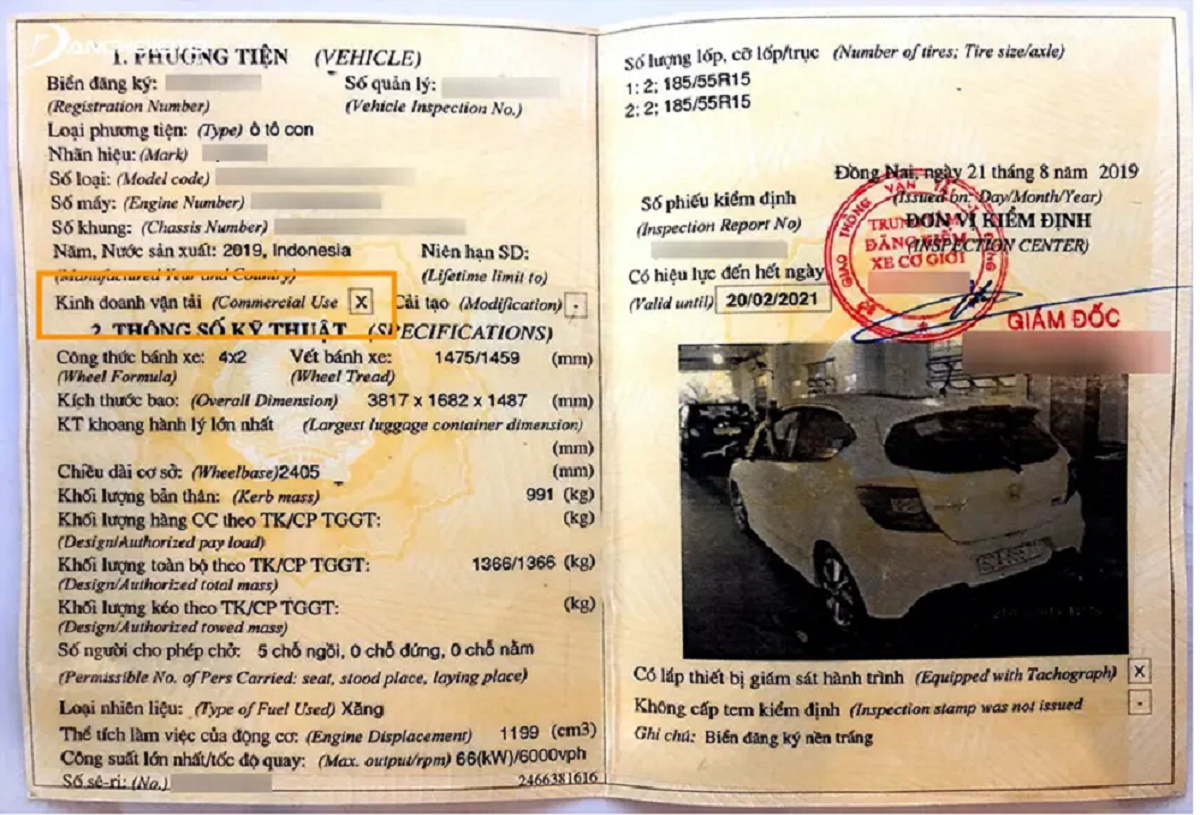To identify a car that has been used as a taxi, service, and then repaired or upgraded for sale, the simplest way is to check the registration certificate.

For vehicles operating professional services such as taxis, the registration certificate has a check mark in the “Transportation business” section. On the other hand, according to regulations, vehicles operating for transportation business have a registration period of 6 months. Meanwhile, vehicles not operating for transportation business have a registration period of 24 months for new vehicles manufactured under 7 years, 12 months for vehicles manufactured from 7-12 years and 6 months for vehicles manufactured over 12 years.
If you want to know whether the vehicle is a taxi or a service vehicle that is repaired and then sold, you need to directly check the registration certificate. In cases where the vehicle owner does not allow the documents to be checked or reports them as lost or the registration certificate shows signs of erasure or changes in content, the vehicle's history may be unclear and unreliable.
However, this method of checking service vehicles can only be applied to professional transport vehicles. As for semi-professional service vehicles, for example, the owner uses the car to run a contract vehicle, Grab, Uber... or rent a self-driving car, the registration certificate will not check the Transport Business section. Therefore, it is difficult for buyers to check in this way.
In general, this is just a reference check. Because many places can fake the vehicle registration book, fake the chassis number - engine number. Therefore, to accurately assess, it is necessary to combine it with checking the actual condition of the vehicle.
To identify a used car that has been used as a taxi or service, you may need to check the following details:
Through the car's paint color, you can recognize signs of a service car that has been repaired.
First, you have to look at the roof of the car, right where the taxi sign is usually placed. If it is a taxi, this place will be newer than the other places.
Next, check the condition of the car's paint and compare it with the time the car has been used. If the car has been used for a long time and the paint is still new, it is likely that the car has been repainted.
Next, we check the chassis paint color. This is a part that is often overlooked when "renovating" a taxi into a private car.
Because the seller thinks that the buyer does not check this detail. If the inspection shows that the chassis has many scratches, even dents, rust… and is much worse than the upper part, then there is a high possibility that the car has been serviced.
Finally, do not ignore the paint on the door sill. In taxis, the number of people getting in and out of the car is very high, so the paint on the sill will be scratched and degraded very quickly. Therefore, if the paint in this position is too new or too old, it should be questioned.
Glass observation
Taxis often have the driver's number on the windshield and rear window, and advertisements on the rear window. Therefore, one way to tell if a car has been a taxi is to look at the windshield and rear window. If there are traces of the driver's number or the glass is discolored, this can be suspected.
Unless the car has had its windows replaced, it is difficult to detect. In order to “blindly” deceive buyers, many car owners also accept to pay for new windows for their cars. If the windows look very new compared to the time the car has been used, you should also be suspicious.
One way to identify a car that has been used as a taxi that many people often use is to check the interior, especially the dashboard. Taxis often have an odometer and fare meter on the dashboard. Therefore, when buying a used car, you should carefully check the dashboard.
If you see a chisel near the cup holder, small holes, uneven surface, or signs of “patchwork”, then it is likely that this is a used taxi. If the dashboard is too new for its age, you should also be suspicious.
Due to high frequency of use, the accelerator/brake pedal (for automatic transmission vehicles) and accelerator/brake/clutch pedal (for manual transmission vehicles) on taxis, service vehicles, etc. will often wear out faster than normal.
In addition, you can check whether the car has ever been serviced or not by the level of deterioration of other details such as the steering wheel, function key system on the dashboard...

The parameters on the odometer are for reference only because it is possible to rewind the odometer on a car, even an electronic clock. But when checking the car, you should also look at it to compare whether the number of kilometers corresponds to the actual condition of the car or not.
To know whether it is a service car or a liquidated taxi, you should carefully observe the seat system, especially the driver's seat. Because service cars are often used a lot and have little maintenance, the seat system will deteriorate very quickly.
With service vehicles, liquidated taxi vehicles, no matter how much modification, it is difficult to change the mechanical system that is more degraded than normal. When test driving the vehicle, this can be checked.
When test driving, turn on the air conditioner at maximum capacity. Drive on different terrains such as: bumpy roads, steep roads... Driving on bad terrain will easily reveal the weaknesses of the engine, chassis system...
HA (according to VTC News)